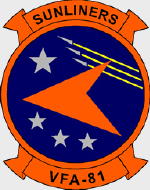Hobby Master HA3571 USN Boeing F/A-18C Hornet Strike Fighter - VFA-81 "Sunliners," USS Saratoga (CV-60), January 1991 [Low Vis Scheme] (1:72 Scale)
"Bigger, Higher, Faster, Farther."
- Thinking within the US Air Force during the late 1970s
 The F/A-18 Hornet is the true multi-role aircraft. It can vault from a carrier deck, bomb a target and stay to dogfight even the best enemy aircraft without missing a beat. It's the Navy's first modern-era jet intended for double duty against air- and ground-based adversaries. Armed to the hilt with Sparrow and Sidewinder air-to-air missiles, an internal cannon, and laser-guided bombs, this modern warbird was an outstanding performer in Operation Desert Storm. Strapped into a digital cockpit described as a cross between Star Wars and a video game, pilots of the F/A-18 Hornet take on the ultimate aviation job: blasting this single-seat, high-performance jet off the deck of a carrier, dropping bombs, and firing air-to-ground ordnance. Offering unmatched agility, the Hornet is the choice aircraft of the US Navy's elite Blue Angels aerobatic team.
The F/A-18 Hornet is the true multi-role aircraft. It can vault from a carrier deck, bomb a target and stay to dogfight even the best enemy aircraft without missing a beat. It's the Navy's first modern-era jet intended for double duty against air- and ground-based adversaries. Armed to the hilt with Sparrow and Sidewinder air-to-air missiles, an internal cannon, and laser-guided bombs, this modern warbird was an outstanding performer in Operation Desert Storm. Strapped into a digital cockpit described as a cross between Star Wars and a video game, pilots of the F/A-18 Hornet take on the ultimate aviation job: blasting this single-seat, high-performance jet off the deck of a carrier, dropping bombs, and firing air-to-ground ordnance. Offering unmatched agility, the Hornet is the choice aircraft of the US Navy's elite Blue Angels aerobatic team.
The F/A-18C is the single-seat variant and the F/A-18D is the two-seat variant. The D-model can be configured for training or as an all-weather strike craft. The "missionized" D model's rear seat is configured for a Marine Corps Naval Flight Officer who functions as a Weapons and Sensors Officer to assist in operating the weapons systems. The F/A-18D is primarily operated by the U.S. Marine Corps in the night attack and Forward Air Controller (Airborne) (FAC(A)) roles.
The F/A-18C and D models are the result of a block upgrade in 1987 incorporating upgraded radar, avionics, and the capacity to carry new missiles such as the AIM-120 AMRAAM air-to-air missile and AGM-65 Maverick and AGM-84 Harpoon air-to-surface missiles. Other upgrades include the Martin-Baker NACES (Navy Aircrew Common ejection seat), and a self-protection jammer. A synthetic aperture ground mapping radar enables the pilot to locate targets in poor visibility conditions. C and D models delivered since 1989 also have improved night attack abilities, consisting of the Hughes AN/AAR-50 thermal navigation pod, the Loral AN/AAS-38 NITE Hawk FLIR (forward looking infrared array) targeting pod, night vision goggles, and two full-color (formerly monochrome) multi-function display (MFDs) and a color moving map.
Pictured here is a gorgeous 1:72 scale diecast replica of a USN Boeing F/A-18C Hornet strike fighter that was attached to VFA-81 "Sunliners," then embarked upon the USS Saratoga (CV-60) in January 1991.
Sold Out!
Dimensions:
Wingspan: 7-1/2-inches
Length: 9-inches
Release Date: February 2023
 Historical Account: "Sunliners" - VFA-81 made three deployments aboard USS Saratoga between 1990 and 1994. On its first cruise operating the F/A-18, VFA-81 participated in the Gulf War. On January 17th, 1991, the first night of the war, LCDR Scott Speicher was shot down and killed while flying an F/A-18C, by a Mig-25PDS piloted by Lt. Zuhair Dawood, 84th Fighter Squadron of the Iraqi Air Force, while flying a mission west of Baghdad.
Historical Account: "Sunliners" - VFA-81 made three deployments aboard USS Saratoga between 1990 and 1994. On its first cruise operating the F/A-18, VFA-81 participated in the Gulf War. On January 17th, 1991, the first night of the war, LCDR Scott Speicher was shot down and killed while flying an F/A-18C, by a Mig-25PDS piloted by Lt. Zuhair Dawood, 84th Fighter Squadron of the Iraqi Air Force, while flying a mission west of Baghdad.
On the same day, the squadron scored the Navy's only two aerial victories over enemy fighters during the campaign by downing two Iraqi MiG-21s. VFA-81 returned to its homeport of NAS Cecil Field, Florida on March 27th, 1991, following the swift coalition victory. The squadron also participated in the last Mediterranean deployment of USS Saratoga, which was decommissioned in August 1994.
In 1996, VFA-81 made a cruise with CVW-17 aboard USS Enterprise, followed by a deployment aboard USS Dwight D. Eisenhower in 1998. Following this cruise, the squadron shifted its homeport to NAS Oceana, Virginia due to the BRAC-mandated closure of NAS Cecil Field in 1999.


